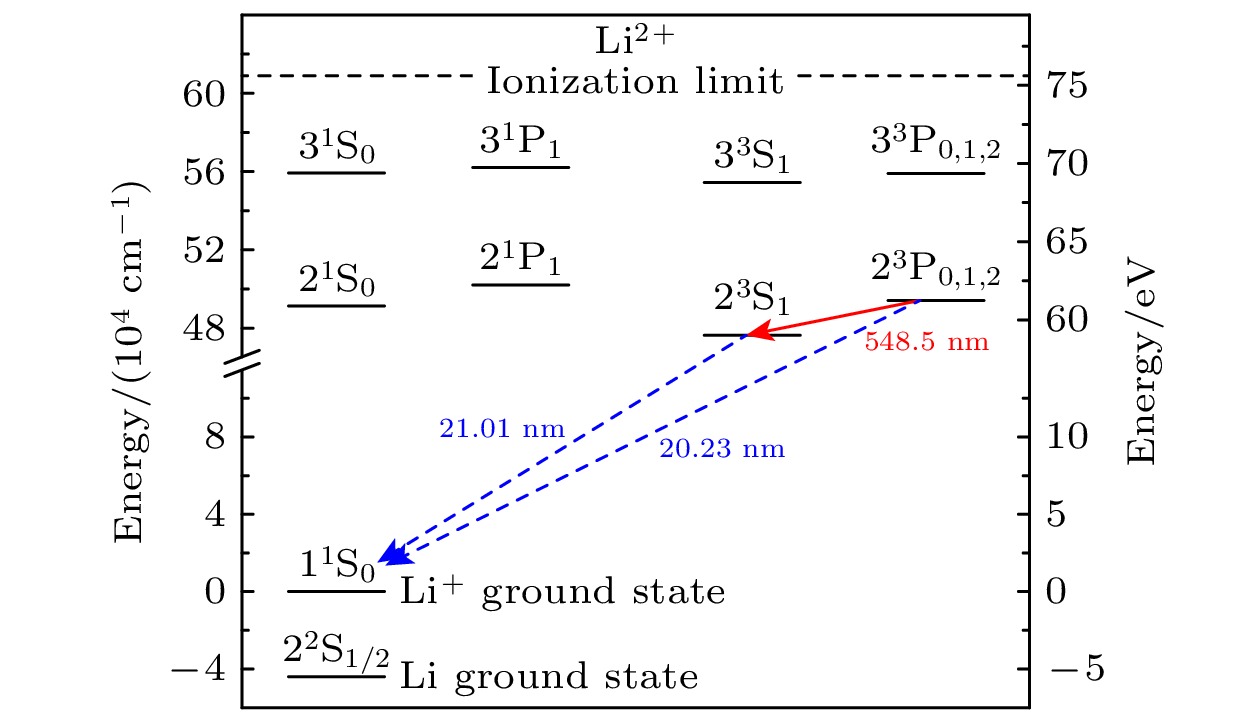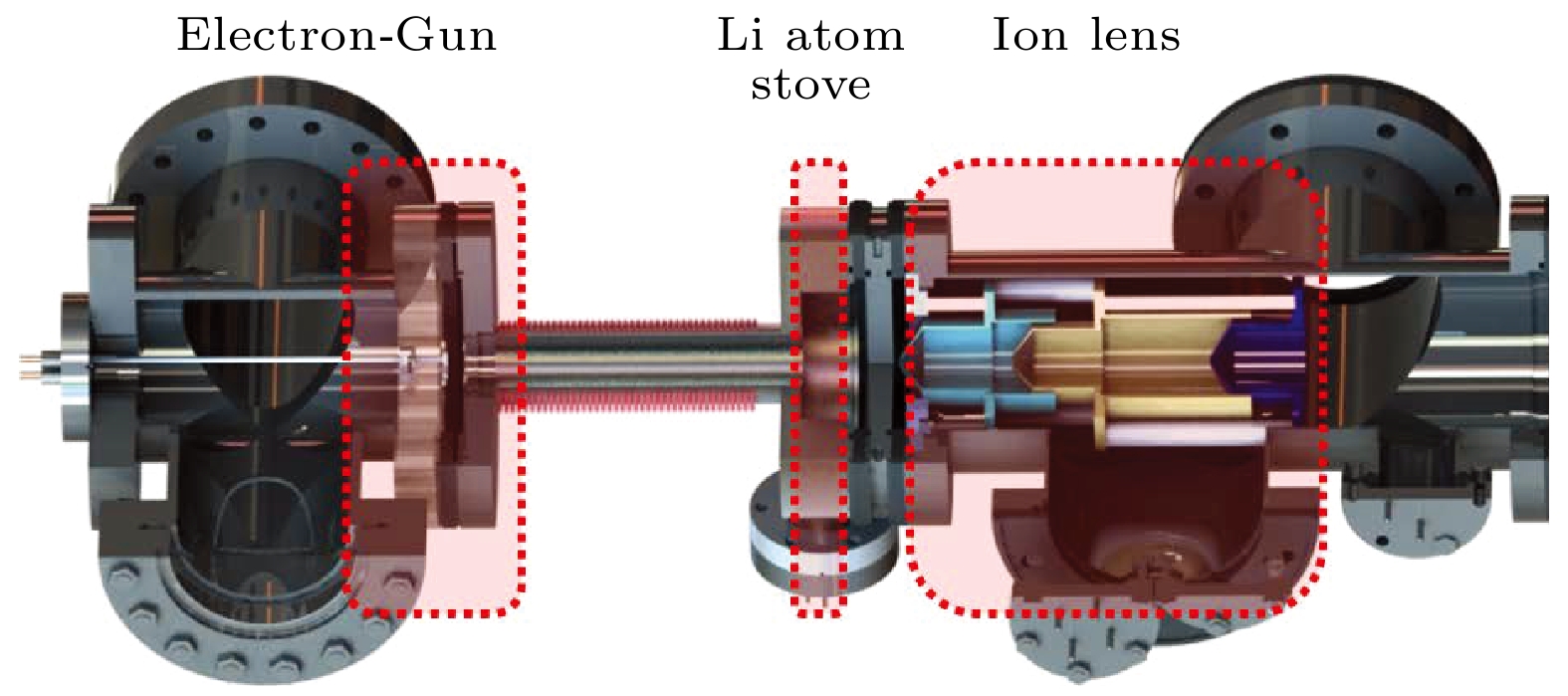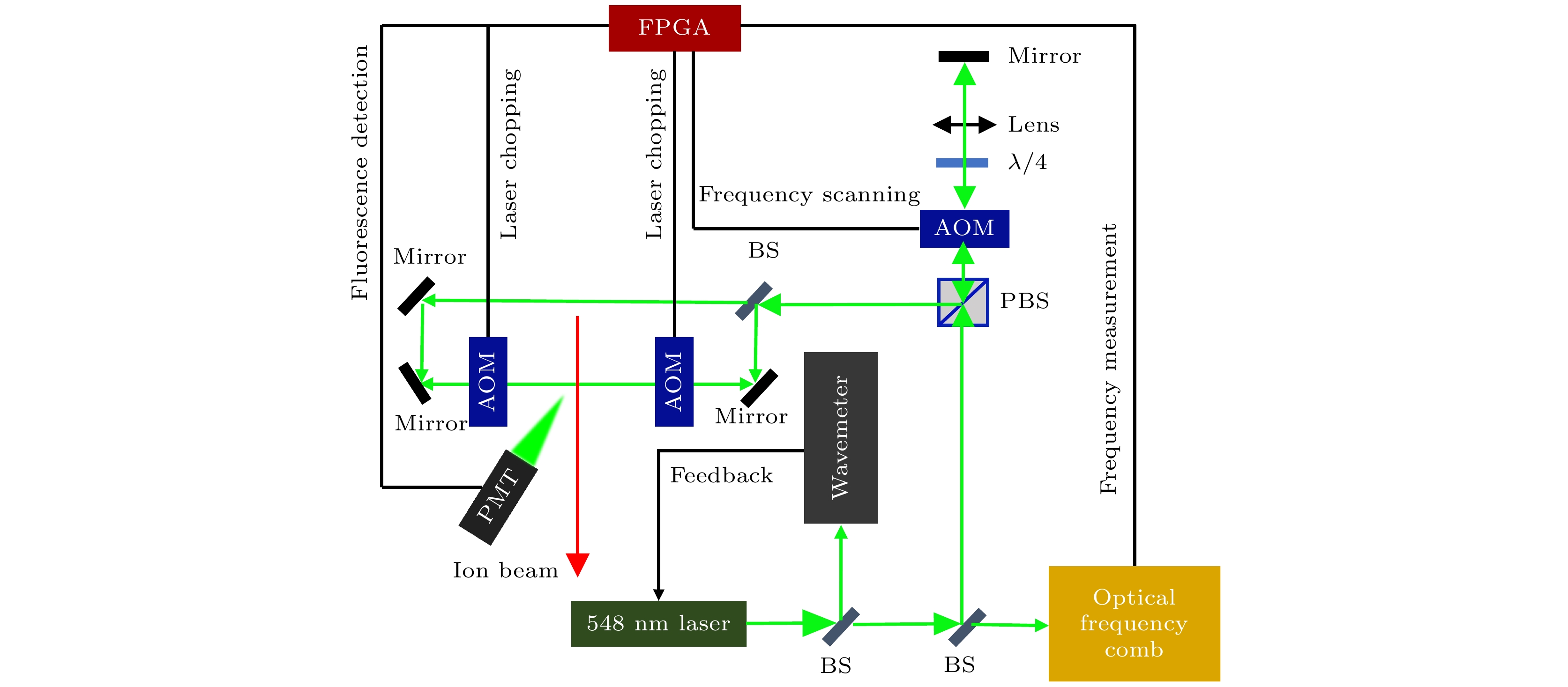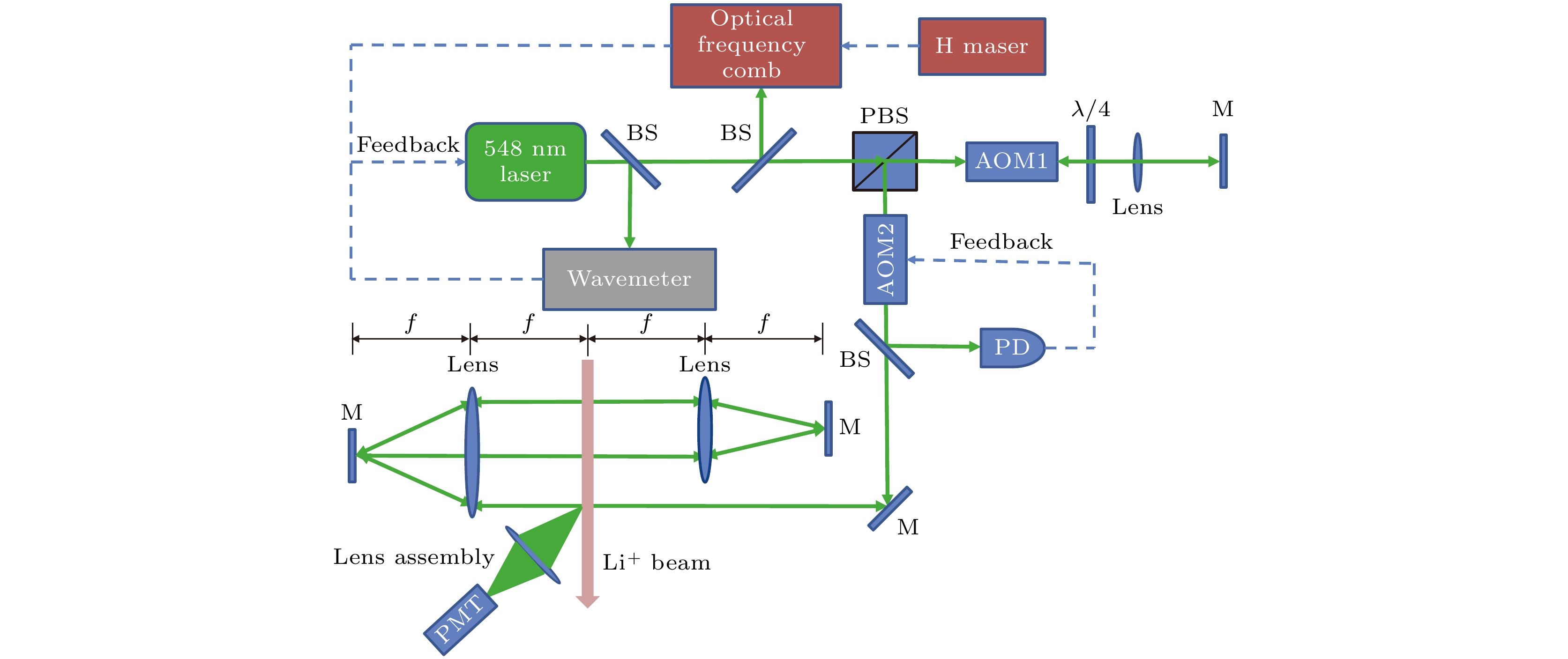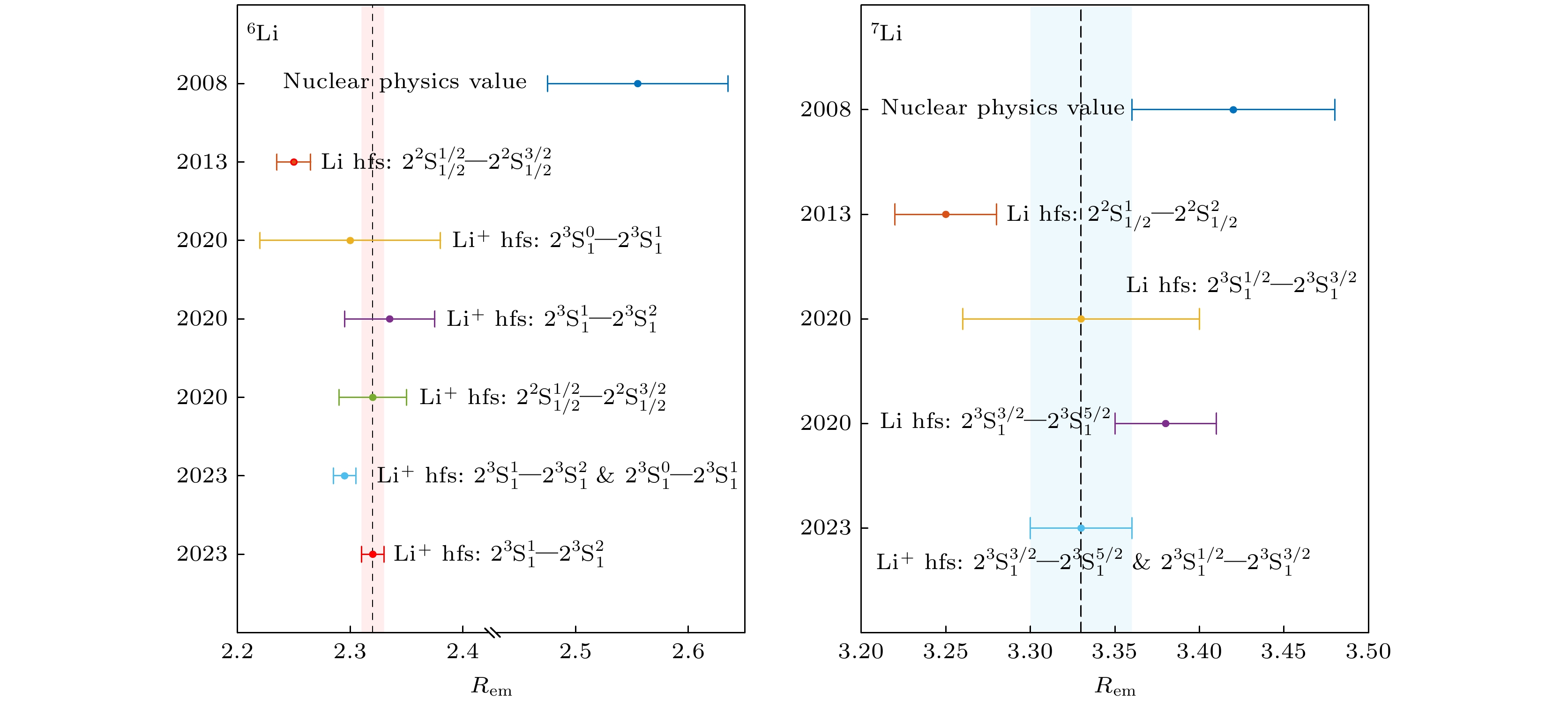-
锂离子精密光谱为束缚态量子电动力学的验证以及原子核结构的研究提供了独特的平台. 本文综述了实验和理论联合研究团队近年来对6,7Li+离子$\,^3{\rm{S}}_1$和$\,^3{\rm{P}}_J$态超精细劈裂的高精度理论计算与实验测量的研究成果. 在理论方面, 理论团队采用束缚态量子电动力学方法对$\,^3{\rm{S}}_1$和$\,^3{\rm{P}}_J$态的超精细劈裂进行了计算, 精确至$m\alpha^6$阶. 在实验方面, 实验团队分别通过饱和荧光光谱法和光学Ramsey方法对7Li+和6Li+离子的超精细劈裂进行了高精度测量, 并由此提取了6,7Li核的Zemach半径. 结果显示, 6Li的Zemach半径与核模型计算值存在显著差异, 揭示了6Li核的奇异特性. 这不仅为原子核结构的探索提供了重要信息, 也将进一步推动少电子原子和分子的精密光谱研究.Precision spectroscopy of lithium ions offers a unique research platform for exploring bound state quantum electrodynamics and investigating the structure of atomic nuclei. This paper overviews our recent efforts dedicated to the precision theoretical calculations and experimental measurements of the hyperfine splittings of 6,7Li+ ions in the $\,^3{\rm{S}}_1$ and $\,^3{\rm{P}}_J$ states. In our theoretical research, we utilize bound state quantum electrodynamics to calculate the hyperfine splitting of the $\,^3{\rm{S}}_1$ and $\,^3{\rm{P}}_J$ states with remarkable precision, achieving an accuracy on the order of $m\alpha^6$. Using Hylleraas basis sets, we first solve the non-relativistic Hamiltonian of the three-body system to derive high-precision energy and wave functions. Subsequently, we consider various orders of relativity and quantum electrodynamics corrections by using the perturbation method, with accuracy of the calculated hyperfine splitting reaching tens of kHz. In our experimental efforts, we developed a low-energy metastable lithium-ion source that provides a stable and continuous ion beam in the $\,^3{\rm{S}}_1$ state. Using this ion beam, we utilize the saturated fluorescence spectroscopy to enhance the precision of hyperfine structure splittings of 7Li+ in the $\,^3{\rm{S}}_1$ and $\,^3{\rm{P}}_J$ states to about 100 kHz. Furthermore, by utilizing the optical Ramsey method, we obtain the most precise values of the hyperfine splittings of 6Li+, with the smallest uncertainty of about 10 kHz. By combining theoretical calculations and experimental measurements, our team have derived the Zemach radii of the 6,7Li nuclei, revealing a significant discrepancy between the Zemach radius of 6Li and the values predicted by the nuclear model. These findings elucidate the distinctive properties of the 6Li nucleus, promote further investigations of atomic nuclei, and advance the precise spectroscopy of few-electron atoms and molecules.
-
Keywords:
- precision spectroscopy /
- quantum electrodynamics /
- Zemach radius
[1] Zheng X, Sun Y R, Chen J J, Jiang W, Pachucki K, Hu S M 2017 Phys. Rev. Lett. 118 063001
 Google Scholar
Google Scholar
[2] Pachucki K, Patkóš V, Yerokhin V A 2017 Phys. Rev. A 95 062510
 Google Scholar
Google Scholar
[3] Heydarizadmotlagh F, Skinner T D G, Kato K, George M C, Hessels E A 2024 Phys. Rev. Lett. 132 163001
 Google Scholar
Google Scholar
[4] Yan Z C, Drake G W F 1995 Phys. Rev. Lett. 74 4791
 Google Scholar
Google Scholar
[5] Sánchez R, Nörtershäuser W, Ewald G, Albers D, Behr J, Bricault P, Bushaw B A, Dax A, Dilling J, Dombsky M, Drake G W F, Götte S, Kirchner R, Kluge H J, Kühl T, Lassen J, Levy C D P, Pearson M R, Prime E J, Ryjkov V, Wojtaszek A, Yan Z C, Zimmermann C 2006 Phys. Rev. Lett. 96 033002
 Google Scholar
Google Scholar
[6] Ewald G, Nörtershäuser W, Dax A, Götte S, Kirchner R, Kluge H J, Kühl T, Sanchez R, Wojtaszek A, Bushaw B A, Drake G W F, Yan Z C, Zimmermann C 2004 Phys. Rev. Lett. 93 113002
 Google Scholar
Google Scholar
[7] Lu Z T, Mueller P, Drake G W F, Nörtershäuser W, Pieper S C, Yan Z C 2013 Rev. Mod. Phys. 85 1383
 Google Scholar
Google Scholar
[8] Kubota Y, Corsi A, Authelet G, Baba H, Caesar C, Calvet D, Delbart A, Dozono M, Feng J, Flavigny F, Gheller J M, Gibelin J, Giganon A, Gillibert A, Hasegawa K, Isobe T, Kanaya Y, Kawakami S, Kim D, Kikuchi Y, Kiyokawa Y, Kobayashi M, Kobayashi N, Kobayashi T, Kondo Y, Korkulu Z, Koyama S, Lapoux V, Maeda Y, Marqués F, M, Motobayashi T, Miyazaki T, Nakamura T, Nakatsuka N, Nishio Y, Obertelli A, Ogata K, Ohkura A, Orr N A, Ota S, Otsu H, Ozaki T, Panin V, Paschalis S, Pollacco E C, Reichert S, Roussé J Y, Saito A T, Sakaguchi S, Sako M, Santamaria C, Sasano M, Sato H, Shikata M, Shimizu Y, Shindo Y, Stuhl L, Sumikama T, Sun Y L, Tabata M, Togano Y, Tsubota J, Yang Z H, Yasuda J, Yoneda K, Zenihiro J, Uesaka T 2020 Phys. Rev. Lett. 125 252501
 Google Scholar
Google Scholar
[9] Drake G W F, Dhindsa H S, Marton V J, 2021 Phys. Rev. A 104 L060801
 Google Scholar
Google Scholar
[10] Knight R D, Prior M H 1980 Phys. Rev. A 21 179
 Google Scholar
Google Scholar
[11] Kowalski J, Neumann R, Noehte S, Scheffzek K, Suhr H, zu Putlitz G 1983 Hyperfine Interact. 15 159
 Google Scholar
Google Scholar
[12] Drake G W F 1971 Phys. Rev. A 3 908
 Google Scholar
Google Scholar
[13] Schüler H 1924 Naturwissenschaften 12 579
[14] Herzberg G, Moore H R 1959 Can. J. Phys. 37 1293
 Google Scholar
Google Scholar
[15] Heisenberg W 1926 Z. Phys. 39 499
 Google Scholar
Google Scholar
[16] Güttinger P, Pauli W 1931 Z. Phys. 67 743
 Google Scholar
Google Scholar
[17] Güttinger P 1930 Z. Physik A 64 749
 Google Scholar
Google Scholar
[18] Macek J 1969 Phys. Rev. Lett. 23 1
 Google Scholar
Google Scholar
[19] Berry H G, Subtil J L 1971 Phys. Rev. Lett. 27 1103
 Google Scholar
Google Scholar
[20] Wing W H, Ruff G A, Lamb W E, Spezeski J J 1976 Phys. Rev. Lett. 36 1488
 Google Scholar
Google Scholar
[21] Fan B, Grischkowsky D, Lurio A 1979 Opt. Lett. 4 233
 Google Scholar
Google Scholar
[22] Fan B, Lurio A, Grischkowsky D 1978 Phys. Rev. Lett. 41 1460
 Google Scholar
Google Scholar
[23] Kötz U, Kowalski J, Neumann R, Noehte S, Suhr H, Winkler K, zu Putlitz G 1981 Z. Phys. A: Hadrons Nucl. 300 25
[24] Englert M, Kowalski J, Mayer F, Neumann R, Noehte S, Schwarzwald P, Suhr H, Winkler K, zu Putlitz G 1982 Sov. J. Quantum Electron. 12 664
 Google Scholar
Google Scholar
[25] Rong H, GrafströM S, Kowalski J, zu Putlitz G, Jastrzebski W, Neumann R 1993 Opt. Commun. 100 268
 Google Scholar
Google Scholar
[26] Riis E, Berry H G, Poulsen O, Lee S A, Tang S Y 1986 Phys. Rev. A 33 3023
 Google Scholar
Google Scholar
[27] Riis E, Sinclair A G, Poulsen O, Drake G W F, Rowley W R C, Levick A P 1994 Phys. Rev. A 49 207
 Google Scholar
Google Scholar
[28] Clarke J J, van Wijngaarden W A 2003 Phys. Rev. A 67 012506
 Google Scholar
Google Scholar
[29] Johnson W R, Cheng K T, Plante D R 1997 Phys. Rev. A 55 2728
 Google Scholar
Google Scholar
[30] Puchalski M, Pachucki K 2013 Phys. Rev. Lett. 111 243001
 Google Scholar
Google Scholar
[31] Yerokhin V A 2008 Phys. Rev. A 78 012513
 Google Scholar
Google Scholar
[32] Li R, Wu Y, Rui Y, Li B, Jiang Y, Ma L, Wu H 2020 Phys. Rev. Lett. 124 063002
 Google Scholar
Google Scholar
[33] Guan H, S. Chen, Qi X Q, S. Liang, Sun W, Zhou P, Huang Y, Zhang P P, Zhong Z X, Yan Z C, Drake G W F, Shi T Y, Gao K 2020 Phys. Rev. A 102 030801
 Google Scholar
Google Scholar
[34] Qi X Q, Zhang P P, Yan Z C, Drake G W F, Zhong Z X, Shi T Y, Chen S L, Huang Y, Guan H, Gao K L 2020 Phys. Rev. Lett. 125 183002
 Google Scholar
Google Scholar
[35] Sun W, Zhang P P, Zhou P P, Chen S L, Zhou Z Q, Huang Y, Qi X Q, Yan Z C, Shi T Y, Drake G W F, Zhong Z X, Guan H, Gao K L 2023 Phys. Rev. Lett. 131 103002
 Google Scholar
Google Scholar
[36] Puchalski M, Pachucki K 2009 Phys. Rev. A 79 032510
 Google Scholar
Google Scholar
[37] Pachucki K, Yerokhin V A, Cancio Pastor P 2012 Phys. Rev. A 85 042517
 Google Scholar
Google Scholar
[38] Patkóš V C V, Yerokhin V A, Pachucki K 2019 Phys. Rev. A 100 042510
 Google Scholar
Google Scholar
[39] Haidar M, Zhong Z X, Korobov V I, Karr J P 2020 Phys. Rev. A 101 022501
 Google Scholar
Google Scholar
[40] Pachucki K, Yerokhin V A 2010 Phys. Rev. Lett. 104 070403
 Google Scholar
Google Scholar
[41] Pachucki K 2006 Phys. Rev. A 74 022512
 Google Scholar
Google Scholar
[42] Yerokhin V A, Pachucki K 2015 J. Phys. Chem. Ref. Data 44 031206
 Google Scholar
Google Scholar
[43] Karshenboim S G, Ivanov V G 2002 Eur. Phys. J. D 19 13
 Google Scholar
Google Scholar
[44] McKenzie D K, Drake G W F 1991 Phys. Rev. A 44 R6973
 Google Scholar
Google Scholar
[45] Yan Z C, Drake G W F 2000 Phys. Rev. A 61 022504
 Google Scholar
Google Scholar
[46] Zemach A C 1956 Phys. Rev. 104 1771
 Google Scholar
Google Scholar
[47] Zhang P P, Zhong Z X, Yan Z C 2013 Phys. Rev. A 88 032519
 Google Scholar
Google Scholar
[48] Chen S L, Liang S Y, Sun W, Huang Y, Guan H, Gao K L 2019 Rev. Sci. Instrum. 90 043112
 Google Scholar
Google Scholar
[49] Artoni M, Carusotto I, Minardi F 2000 Phys. Rev. A 62 023402
 Google Scholar
Google Scholar
[50] Brown R C, Wu S J, Porto J V, Sansonetti C J, Simien C E, Brewer S M, Tan J N, Gillaspy J D 2013 Phys. Rev. A 87 032504
 Google Scholar
Google Scholar
[51] Beyer A, Maisenbacher L, Matveev A, Pohl R, Khabarova K, Grinin A, Lamour T, Yost D C, Hänsch T W, Kolachevsky N, Udem T 2017 Science 358 79
 Google Scholar
Google Scholar
[52] Ramsey N F 1950 Phys. Rev. 78 695
 Google Scholar
Google Scholar
[53] Zhou P P, Sun W, Liang S Y, Chen S L, Zhou Z Q, Huang Y, Guan H, Gao K L 2021 Appl. Opt. 60 6097
 Google Scholar
Google Scholar
[54] Stone N 2016 At. Data Nucl. Data Tables 111 1
[55] Pachucki K, Patkóš V, Yerokhin V A 2023 Phys. Rev. A 108 052802
 Google Scholar
Google Scholar
-
图 5 7Li+离子${2\, ^3{\rm{P}}_{2}}$态中F = 1/2和F = 3/2的超精细劈裂测量[33] (a)纯净的Lamb凹陷信号及其Voigt-Fano线形拟合; (b)测量值的统计分布; (c)测量数据的直方图
Fig. 5. Measurement of the hyperfine splitting of the ${2\, ^3{\rm{P}}_{2}}$ state for 7Li+ between F = 1/2 and F = 3/2[33]: (a) The pure Lamb dip signal and its Voigt-Fano line shape fitting; (b) statistical distribution of the measured values; (c) histogram of the measurement data.
图 7 6Li+离子超精细结构劈裂$^3{\rm{P}}_1^{0-1}$的测量[35] (a)某条跃迁的单次Ramsey光谱, 红实线表示由高斯函数与正弦函数乘积构成的线型对实验数据的拟合; (b)6Li+离子超精细结构劈裂$^3{\rm{P}}_1^{0-1}$的实验结果
Fig. 7. Measurement of the $^3{\rm{P}}_1^{0-1}$ interval in 6Li+[35]: (a) Ramsey spectrum from a single scan of one of the measured transitions. The solid red line is an experimental data fit to a Gaussian-damped sinusoidal function. Residuals of the fit are shown in the lower panel. (b) Experimental results for the $^3{\rm{P}}_1^{0-1}$ interval of 6Li+.
图 8 6Li+离子超精细结构劈裂$ {^3{\rm{P}}_1^{1-2}} $测量结果对激光相对于探测器极化角度的依赖. (a)和(b)分别是通过高斯和Fano-Voigt函数拟合获得的数据
Fig. 8. Dependence of the measured hyperfine interval $ {^3{\rm{P}}_1^{1-2}} $ of 6Li+ on laser polarization angle relative to the direction of the photodetector. (a) and (b) are obtained by fitting the envelope with a Gaussian and Fano-Voigt function, respectively.
表 1 Li+ 离子$ 2\, ^3{\rm{P}}_2 $态中F = 3/2和F = 5/2之间超精细劈裂误差表, 单位为 kHz[33]
Table 1. Uncertainty budget for the hyperfine splitting between F = 3/2 and F = 5/2 in $ 2\, ^3{\rm{P}}_2 $ of Li+, in kHz[33]
误差来源 $ \delta\nu $ 统计误差 44 1阶Doppler效应 < 1 2阶Doppler效应 < 1 激光功率 11 激光频率测量 5 Zeeman效应 1 量子干涉效应 27 总误差 53 表 2 6Li+离子$2\, ^3{\rm{S}}_1$和 $2\, ^3{\rm{P}}_{1, 2}$态超精细劈裂测量值及误差, 单位kHz[35]
Table 2. The measured values and errors of the hyperfine splittings in the $2\, ^3{\rm{S}}_1$ and $2\, ^3{\rm{P}}_{1, 2}$ states of 6Li+ ions, in units of kHz[35].
误差来源 $2\, { ^{3}{\rm{S}}_{1}^{0-1}}$ ${2\, ^{3}{\rm{S}}_{1}^{1-2}}$ ${2\, ^{3}{\rm{P}}_{1}^{0-1}}$ ${2\, ^{3}{\rm{P}}_{1}^{1-2}}$ ${2\, ^{3}{\rm{P}}_{2}^{1-2}}$ ${2\, ^{3}{\rm{P}}_{2}^{2-3}}$ 统计误差 3001783(6) 6003618(4) 1317652(6) 288423(4) 2858019(6) 4127891(4) 一阶Doppler效应 (3.5) (3.5) (3.5) (3.5) (3.5) (3.5) 二阶Doppler效应 0.27(1) 0.54(3) 0.12(1) 0.26(1) 0.26(1) 0.37(2) 激光功率 (5.0) (5.0) (5.0) (5.0) (5.0) (5.0) Zeeman效应 (6.3) (0.3) (1.6) (3.2) (3.2) (1.6) 量子干涉效应 (8) (8) (8) (8) (8) (8) 总误差 3001783(13) 6003619(11) 1317652(12) 288423(11) 2858019(12) 4127891(11) 表 3 6Li+离子$2\, ^3{\rm{S}}_1$和$2\, ^3{\rm{P}}_J$态的超精细劈裂, 单位 MHz[34,35]. 理论计算中使用的核电四极矩为–0.0806(6) fm2[54], Zemach半径为2.44(2) fm
Table 3. Hyperfine splittings in the $2\, ^3{\rm{S}}_1$ and $2\, ^3{\rm{P}}_J$ states of 6Li+, in MHz[34,35]. The nuclear electric quadrupole moment used in theory is –0.0806(6) fm2[54] and the Zemach radius used is 2.44(2) fm
实验 理论 Kowalski et al.[11] Clarke et al.[28] Sun et al.[35] Drake et al.[27] Qi et al.[34] Sun et al.[35] $2\, ^3{\rm{S}}_1^{0-1}$ 3001.780(50) 3001.83(47) 3001.782(18) 3001.765(38) $2\, ^3{\rm{S}}_1^{1-2}$ 6003.600(50) 6003.66(51) 6003.620(8) 6003.614(24) $2\, ^3{\rm{P}}_1^{0-1}$ 1316.06(59) 1317.647(40) 1317.649(46) 1317.732(31) 1317.736(15) $2\, ^3{\rm{P}}_1^{1-2}$ 2888.98(63) 2888.429(21) 2888.327(29) 2888.379(20) 2888.391(10) $2\, ^3{\rm{P}}_2^{1-2}$ 2857.00(72) 2858.028(27) 2858.002(60) 2857.962(43) 2857.972(21) $2\, ^3{\rm{P}}_2^{2-3}$ 4127.16(76) 4127.886(13) 4127.882(43) 4127.924(31) 4127.937(15) 表 4 7Li+离子2 3S1和$ 2\, ^3{\rm{P}}_J $态的超精细劈裂, 单位 MHz[33,34]. 理论计算中使用的核电四极矩为–4.00(3) fm2 [54], Zemach半径为3.38(3) fm
Table 4. Hyperfine splittings in the 2 3S1 and $ 2\, ^3{\rm{P}}_J $ states of 7Li+, in MHz[33,34]. The nuclear electric quadrupole moment used is –4.00(3) fm2 [54] and the Zemach radius used is 3.38(3) fm
实验 理论 Kötz et al.[11,23] Clarke et al.[28] Guan et al.[33] Drake et al.[27] Qi et al.[34] $ 2\, ^3{\rm{S}}_1^{1/2-3/2} $ 11890.018(40) 11891.22(60) 11890.088(65) 11890.013(38) $ 2\, ^3{\rm{S}}_1^{3/2-5/2} $ 19817.673(40) 19817.90(93) 19817.696(42) 19817.680(25) $ 2\, ^3{\rm{P}}_1^{1/2-3/2} $ 4237.8(10) 4239.11(54) 4238.823(111) 4238.86(20) 4238.920(49) $ 2\, ^3{\rm{P}}_1^{3/2-5/2} $ 9965.2(6) 9966.30(69) 9966.655(102) 9966.14(13) 9966.444(34) $ 2\, ^3{\rm{P}}_2^{1/2-3/2} $ 6203.6(5) 6204.52(80) 6203.319(67) 6203.27(30) 6203.408(95) $ 2\, ^3{\rm{P}}_2^{3/2-5/2} $ 9608.7(20) 9608.90(49) 9608.220(54) 9608.12(15) 9608.311(54) $ 2\, ^3{\rm{P}}_2^{5/2-7/2} $ 11775.8(5) 11774.04(94) 11772.965(74) 11773.05(18) 11773.003(55) 表 5 通过2 3S1态的超精细劈裂确定的Zemach半径, 单位 fm
Table 5. Determination of the Zemach radii by the hyperfine splittings of the 2 3S1 state, in fm
6Li+ 7Li+ $A_{\rm{the}}/{\mathrm{kHz}} $[55] 2997908.1(1.4) 7917508.1(1.3) $A_{\rm{exp}}/{\mathrm{kHz}} $(Guan et al.)[33] 3001805.1(7) 7926990.1(2.3) $a_\mathrm{e} + \delta_{\rm QED} $[55] 0.0015709(5) 0.0015749(5) $\delta_{\rm{HO}}=A_{\rm{exp}}/A_{\rm the}-1$ 0.0012999(24) 0.0011976(29) $\delta_{\rm{ZM}}$ –0.0002710(24) –0.0003773(30) $R_{\rm{em}} $ (Pachucki et al.)[55] 2.39(2) 3.33(3) $R_{\rm{em}} $ (Sun et al.)[35] 2.44(2) $R_{\rm{em}} $ (Qi et al.)[34] 2.47(8) 3.38(3) $R_{\rm{em}} $ (Qi et al.)[34] 2.40(16) 3.33(7) $R_{\rm{em}} $ (Puchalski et al.)[30] 2.29(4) 3.23(4) $R_{\rm{em}} $ (核模型值)[31] 3.71(16) 3.42(6) $R_{\rm{em}} $ (Li et al.)[30,32] 2.44(6) -
[1] Zheng X, Sun Y R, Chen J J, Jiang W, Pachucki K, Hu S M 2017 Phys. Rev. Lett. 118 063001
 Google Scholar
Google Scholar
[2] Pachucki K, Patkóš V, Yerokhin V A 2017 Phys. Rev. A 95 062510
 Google Scholar
Google Scholar
[3] Heydarizadmotlagh F, Skinner T D G, Kato K, George M C, Hessels E A 2024 Phys. Rev. Lett. 132 163001
 Google Scholar
Google Scholar
[4] Yan Z C, Drake G W F 1995 Phys. Rev. Lett. 74 4791
 Google Scholar
Google Scholar
[5] Sánchez R, Nörtershäuser W, Ewald G, Albers D, Behr J, Bricault P, Bushaw B A, Dax A, Dilling J, Dombsky M, Drake G W F, Götte S, Kirchner R, Kluge H J, Kühl T, Lassen J, Levy C D P, Pearson M R, Prime E J, Ryjkov V, Wojtaszek A, Yan Z C, Zimmermann C 2006 Phys. Rev. Lett. 96 033002
 Google Scholar
Google Scholar
[6] Ewald G, Nörtershäuser W, Dax A, Götte S, Kirchner R, Kluge H J, Kühl T, Sanchez R, Wojtaszek A, Bushaw B A, Drake G W F, Yan Z C, Zimmermann C 2004 Phys. Rev. Lett. 93 113002
 Google Scholar
Google Scholar
[7] Lu Z T, Mueller P, Drake G W F, Nörtershäuser W, Pieper S C, Yan Z C 2013 Rev. Mod. Phys. 85 1383
 Google Scholar
Google Scholar
[8] Kubota Y, Corsi A, Authelet G, Baba H, Caesar C, Calvet D, Delbart A, Dozono M, Feng J, Flavigny F, Gheller J M, Gibelin J, Giganon A, Gillibert A, Hasegawa K, Isobe T, Kanaya Y, Kawakami S, Kim D, Kikuchi Y, Kiyokawa Y, Kobayashi M, Kobayashi N, Kobayashi T, Kondo Y, Korkulu Z, Koyama S, Lapoux V, Maeda Y, Marqués F, M, Motobayashi T, Miyazaki T, Nakamura T, Nakatsuka N, Nishio Y, Obertelli A, Ogata K, Ohkura A, Orr N A, Ota S, Otsu H, Ozaki T, Panin V, Paschalis S, Pollacco E C, Reichert S, Roussé J Y, Saito A T, Sakaguchi S, Sako M, Santamaria C, Sasano M, Sato H, Shikata M, Shimizu Y, Shindo Y, Stuhl L, Sumikama T, Sun Y L, Tabata M, Togano Y, Tsubota J, Yang Z H, Yasuda J, Yoneda K, Zenihiro J, Uesaka T 2020 Phys. Rev. Lett. 125 252501
 Google Scholar
Google Scholar
[9] Drake G W F, Dhindsa H S, Marton V J, 2021 Phys. Rev. A 104 L060801
 Google Scholar
Google Scholar
[10] Knight R D, Prior M H 1980 Phys. Rev. A 21 179
 Google Scholar
Google Scholar
[11] Kowalski J, Neumann R, Noehte S, Scheffzek K, Suhr H, zu Putlitz G 1983 Hyperfine Interact. 15 159
 Google Scholar
Google Scholar
[12] Drake G W F 1971 Phys. Rev. A 3 908
 Google Scholar
Google Scholar
[13] Schüler H 1924 Naturwissenschaften 12 579
[14] Herzberg G, Moore H R 1959 Can. J. Phys. 37 1293
 Google Scholar
Google Scholar
[15] Heisenberg W 1926 Z. Phys. 39 499
 Google Scholar
Google Scholar
[16] Güttinger P, Pauli W 1931 Z. Phys. 67 743
 Google Scholar
Google Scholar
[17] Güttinger P 1930 Z. Physik A 64 749
 Google Scholar
Google Scholar
[18] Macek J 1969 Phys. Rev. Lett. 23 1
 Google Scholar
Google Scholar
[19] Berry H G, Subtil J L 1971 Phys. Rev. Lett. 27 1103
 Google Scholar
Google Scholar
[20] Wing W H, Ruff G A, Lamb W E, Spezeski J J 1976 Phys. Rev. Lett. 36 1488
 Google Scholar
Google Scholar
[21] Fan B, Grischkowsky D, Lurio A 1979 Opt. Lett. 4 233
 Google Scholar
Google Scholar
[22] Fan B, Lurio A, Grischkowsky D 1978 Phys. Rev. Lett. 41 1460
 Google Scholar
Google Scholar
[23] Kötz U, Kowalski J, Neumann R, Noehte S, Suhr H, Winkler K, zu Putlitz G 1981 Z. Phys. A: Hadrons Nucl. 300 25
[24] Englert M, Kowalski J, Mayer F, Neumann R, Noehte S, Schwarzwald P, Suhr H, Winkler K, zu Putlitz G 1982 Sov. J. Quantum Electron. 12 664
 Google Scholar
Google Scholar
[25] Rong H, GrafströM S, Kowalski J, zu Putlitz G, Jastrzebski W, Neumann R 1993 Opt. Commun. 100 268
 Google Scholar
Google Scholar
[26] Riis E, Berry H G, Poulsen O, Lee S A, Tang S Y 1986 Phys. Rev. A 33 3023
 Google Scholar
Google Scholar
[27] Riis E, Sinclair A G, Poulsen O, Drake G W F, Rowley W R C, Levick A P 1994 Phys. Rev. A 49 207
 Google Scholar
Google Scholar
[28] Clarke J J, van Wijngaarden W A 2003 Phys. Rev. A 67 012506
 Google Scholar
Google Scholar
[29] Johnson W R, Cheng K T, Plante D R 1997 Phys. Rev. A 55 2728
 Google Scholar
Google Scholar
[30] Puchalski M, Pachucki K 2013 Phys. Rev. Lett. 111 243001
 Google Scholar
Google Scholar
[31] Yerokhin V A 2008 Phys. Rev. A 78 012513
 Google Scholar
Google Scholar
[32] Li R, Wu Y, Rui Y, Li B, Jiang Y, Ma L, Wu H 2020 Phys. Rev. Lett. 124 063002
 Google Scholar
Google Scholar
[33] Guan H, S. Chen, Qi X Q, S. Liang, Sun W, Zhou P, Huang Y, Zhang P P, Zhong Z X, Yan Z C, Drake G W F, Shi T Y, Gao K 2020 Phys. Rev. A 102 030801
 Google Scholar
Google Scholar
[34] Qi X Q, Zhang P P, Yan Z C, Drake G W F, Zhong Z X, Shi T Y, Chen S L, Huang Y, Guan H, Gao K L 2020 Phys. Rev. Lett. 125 183002
 Google Scholar
Google Scholar
[35] Sun W, Zhang P P, Zhou P P, Chen S L, Zhou Z Q, Huang Y, Qi X Q, Yan Z C, Shi T Y, Drake G W F, Zhong Z X, Guan H, Gao K L 2023 Phys. Rev. Lett. 131 103002
 Google Scholar
Google Scholar
[36] Puchalski M, Pachucki K 2009 Phys. Rev. A 79 032510
 Google Scholar
Google Scholar
[37] Pachucki K, Yerokhin V A, Cancio Pastor P 2012 Phys. Rev. A 85 042517
 Google Scholar
Google Scholar
[38] Patkóš V C V, Yerokhin V A, Pachucki K 2019 Phys. Rev. A 100 042510
 Google Scholar
Google Scholar
[39] Haidar M, Zhong Z X, Korobov V I, Karr J P 2020 Phys. Rev. A 101 022501
 Google Scholar
Google Scholar
[40] Pachucki K, Yerokhin V A 2010 Phys. Rev. Lett. 104 070403
 Google Scholar
Google Scholar
[41] Pachucki K 2006 Phys. Rev. A 74 022512
 Google Scholar
Google Scholar
[42] Yerokhin V A, Pachucki K 2015 J. Phys. Chem. Ref. Data 44 031206
 Google Scholar
Google Scholar
[43] Karshenboim S G, Ivanov V G 2002 Eur. Phys. J. D 19 13
 Google Scholar
Google Scholar
[44] McKenzie D K, Drake G W F 1991 Phys. Rev. A 44 R6973
 Google Scholar
Google Scholar
[45] Yan Z C, Drake G W F 2000 Phys. Rev. A 61 022504
 Google Scholar
Google Scholar
[46] Zemach A C 1956 Phys. Rev. 104 1771
 Google Scholar
Google Scholar
[47] Zhang P P, Zhong Z X, Yan Z C 2013 Phys. Rev. A 88 032519
 Google Scholar
Google Scholar
[48] Chen S L, Liang S Y, Sun W, Huang Y, Guan H, Gao K L 2019 Rev. Sci. Instrum. 90 043112
 Google Scholar
Google Scholar
[49] Artoni M, Carusotto I, Minardi F 2000 Phys. Rev. A 62 023402
 Google Scholar
Google Scholar
[50] Brown R C, Wu S J, Porto J V, Sansonetti C J, Simien C E, Brewer S M, Tan J N, Gillaspy J D 2013 Phys. Rev. A 87 032504
 Google Scholar
Google Scholar
[51] Beyer A, Maisenbacher L, Matveev A, Pohl R, Khabarova K, Grinin A, Lamour T, Yost D C, Hänsch T W, Kolachevsky N, Udem T 2017 Science 358 79
 Google Scholar
Google Scholar
[52] Ramsey N F 1950 Phys. Rev. 78 695
 Google Scholar
Google Scholar
[53] Zhou P P, Sun W, Liang S Y, Chen S L, Zhou Z Q, Huang Y, Guan H, Gao K L 2021 Appl. Opt. 60 6097
 Google Scholar
Google Scholar
[54] Stone N 2016 At. Data Nucl. Data Tables 111 1
[55] Pachucki K, Patkóš V, Yerokhin V A 2023 Phys. Rev. A 108 052802
 Google Scholar
Google Scholar
计量
- 文章访问数: 4580
- PDF下载量: 171
- 被引次数: 0














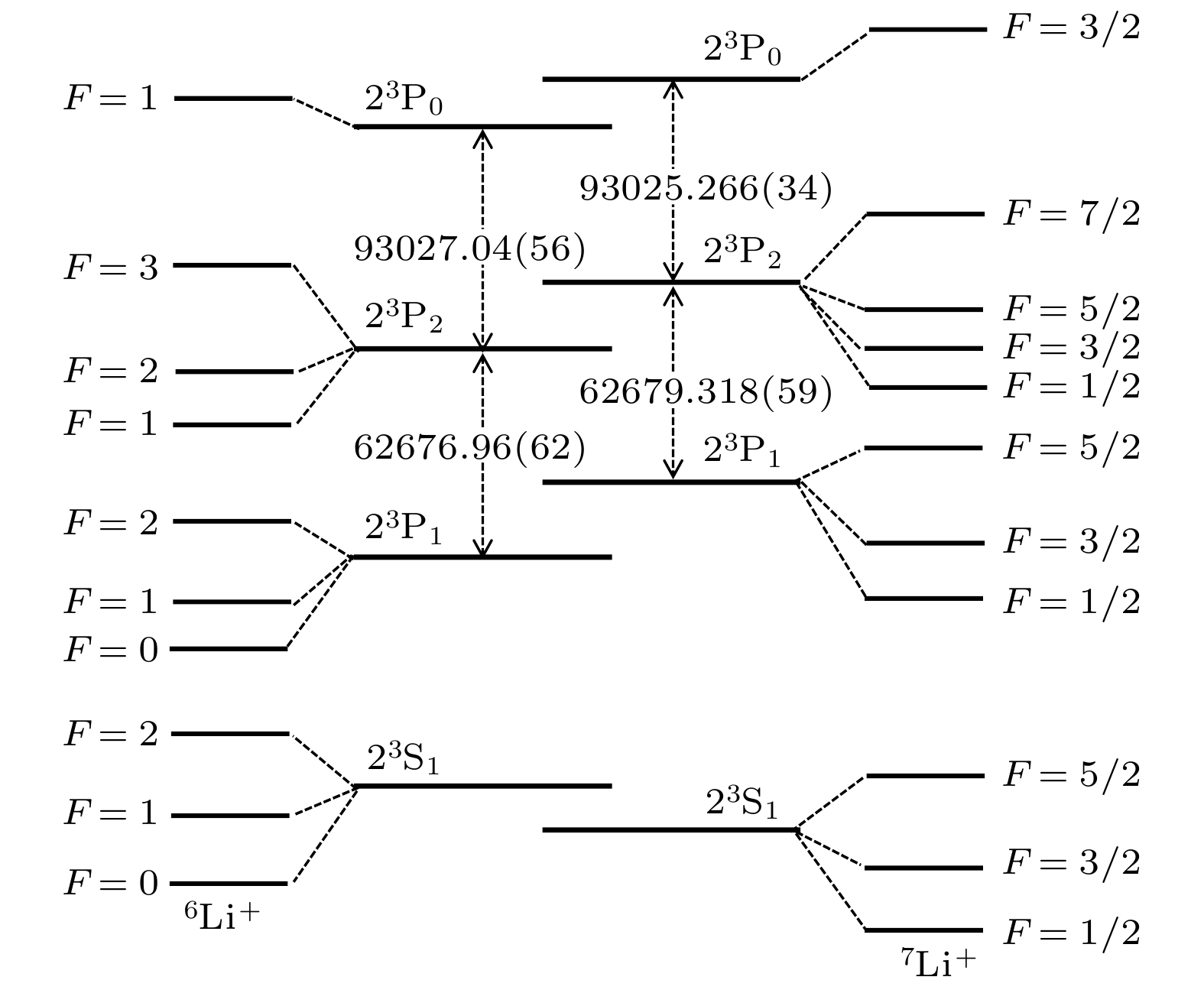
 下载:
下载:
